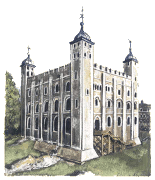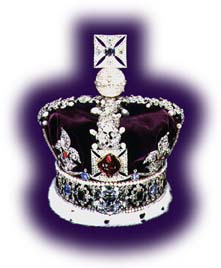
 Crown Jewels
Crown Jewels

During medieval times Crown Jewels were the personal property of the sovereign.
It was fairly common practice for the King or Queen to pawn them or use them as security for loans in time of war.
Most were kept at the Tower, particularly when the sovereign was in residence there, although the Coronation Regalia was held at Westminster Abbey. Sometime after 1660, a new set of Regalia was made to replace what had been destroyed during the Commonwealth. It was at that time that the Tower became the permanent home of the Crown Jewels and put on public display.
Sometime after 1660, a new set of Regalia was made to replace what had been destroyed during the Commonwealth. It was at that time that the Tower became the permanent home of the Crown Jewels and put on public display.
The present crown is about the tenth manifestation since the Restoration. It was originally designed and made for
Queen Victoria in 1838 and was used at the coronations of Edward VII and George V.
It was remade with practically the
same stones for George VI in 1937. For the coronation of Queen Elizabeth II in 1953 the shape of the arches was altered to
reduce the height. Although more than 2,800 diamonds are mounted in it, the crown is best known for it's
major stones, famous either for their historical interest or their actual value.
 It is against the royal constitution for monarchs to take any of the royal regalia out of the country.
It is against the royal constitution for monarchs to take any of the royal regalia out of the country.
The ban probably
coming into effect to prevent many monarchs from selling or pawning the Crown Jewels when they need the money.
Charles I for example sold a great deal of jewels at the start of the civil war to raise the funds in order to pay for his troops.
As a consequence when George V, as emperor of India, attended the Delhi Durbar in 1911 to receive the homage of the Indian princes,
a new crown was required. It was supplied by the present Crown Jewellers and the cost of �60,000 was met by the India Office.
The Crown is one of the heaviest in the collection (weighing 34.5oz) and is set with emeralds, rubies, sapphires and some 6,100 diamonds.
On George V's return to Britain the Crown was added to the collection in the jewel house and has not been worn since.
